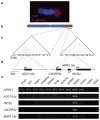Convergent evolution of chicken Z and human X chromosomes by expansion and gene acquisition
- PMID: 20622855
- PMCID: PMC2943333
- DOI: 10.1038/nature09172
Convergent evolution of chicken Z and human X chromosomes by expansion and gene acquisition
Abstract
In birds, as in mammals, one pair of chromosomes differs between the sexes. In birds, males are ZZ and females ZW. In mammals, males are XY and females XX. Like the mammalian XY pair, the avian ZW pair is believed to have evolved from autosomes, with most change occurring in the chromosomes found in only one sex--the W and Y chromosomes. By contrast, the sex chromosomes found in both sexes--the Z and X chromosomes--are assumed to have diverged little from their autosomal progenitors. Here we report findings that challenge this assumption for both the chicken Z chromosome and the human X chromosome. The chicken Z chromosome, which we sequenced essentially to completion, is less gene-dense than chicken autosomes but contains a massive tandem array containing hundreds of duplicated genes expressed in testes. A comprehensive comparison of the chicken Z chromosome with the finished sequence of the human X chromosome demonstrates that each evolved independently from different portions of the ancestral genome. Despite this independence, the chicken Z and human X chromosomes share features that distinguish them from autosomes: the acquisition and amplification of testis-expressed genes, and a low gene density resulting from an expansion of intergenic regions. These features were not present on the autosomes from which the Z and X chromosomes originated but were instead acquired during the evolution of Z and X as sex chromosomes. We conclude that the avian Z and mammalian X chromosomes followed convergent evolutionary trajectories, despite their evolving with opposite (female versus male) systems of heterogamety. More broadly, in birds and mammals, sex chromosome evolution involved not only gene loss in sex-specific chromosomes, but also marked expansion and gene acquisition in sex chromosomes common to males and females.
Conflict of interest statement
The authors declare no competing financial interests.
Figures



References
-
- Muller HJ. A gene for the fourth chromosome of Drosophila. Journal of Experimental Zoology. 1914;17:325–336.
-
- Ohno S. Sex chromosomes and sex-linked genes. Springer-Verlag; New York: 1967.
-
- Lahn BT, Page DC. Four evolutionary strata on the human X chromosome. Science. 1999;286:964–7. - PubMed
-
- Skaletsky H, et al. The male-specific region of the human Y chromosome is a mosaic of discrete sequence classes. Nature. 2003;423:825–37. - PubMed
Publication types
MeSH terms
Grants and funding
LinkOut - more resources
Full Text Sources
Medical

